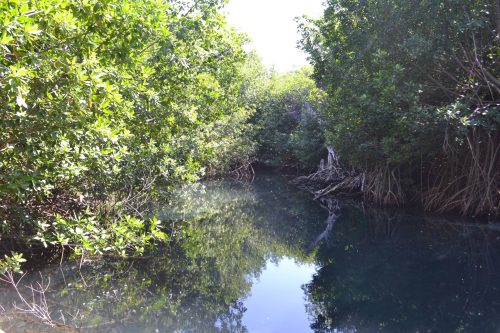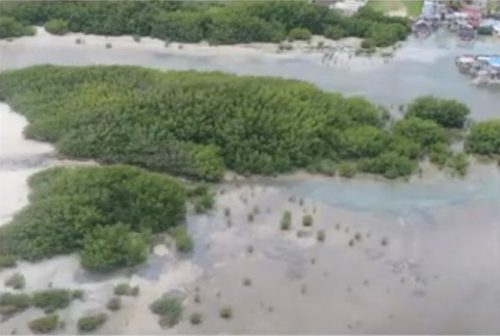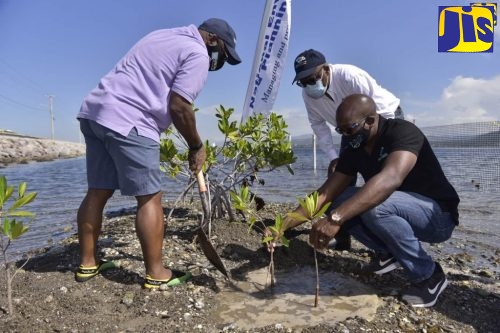Jamaica’s Mangroves Worth Millions
By: , November 16, 2022The Full Story
Mangroves, the groups of trees and shrubs that line Jamaica’s coastlines, hold significant value not only in protecting and sustaining the lives and livelihoods of citizens along the coasts but also in real economic terms.
It is estimated that these wetland forests are worth hundreds of millions of dollars.
A report on Jamaica’s mangroves, launched in 2019, estimate that they provide approximately US$32.7 million in protection to Jamaica’s heavily settled coastline areas.
The study, funded by the Program on Forests (PROFOR) through the World Bank, found that without mangroves, the estimated damage from flooding would be US$169 million annually.
When the protection of approximately US$2.4 billion in assets (people and infrastructure) during storms is factored in, the value of mangroves is more than US$186 million per hectare.
Director for the Centre of Marine Sciences at the University of the West Indies (UWI) Mona Campus, Professor Mona Kay Webber, tells JIS News that the value of mangroves is directly related to what they protect.

With these areas worth up to about US$900,000 per hectare, per year in 2006, it is evident that the value of mangroves continues to increase over time.
“A mangrove could protect part of the coastal road as well as the hotel. This adds to the actual value of the mangrove ecosystem itself,” Professor Webber says.
“Mangroves protect shorelines, so they stop erosion and reduce sediment flow into the water. All the turbidity and dirty water that flows from the land, mangrove forests intercept those and reduce the amount of sediments flowing in the marine environment,” she points out further.
But, the benefits of mangroves go beyond storm and flood protection.
According to the PROFOR study, which also involved the National Environment and Planning Agency (NEPA); the Office of Disaster Preparedness and Emergency Management (ODPEM); the University of California, Santa Cruz and UWI, approximately 3.7 million tons of carbon are sequestered annually by Jamaica’s mangroves.
They also contribute between US$5,218 (at Salt Marsh, Trelawny) and US$54,145 (at Portland Cottage, Clarendon) in mixed fisheries per hectare, per year.
The mangroves, which are normally found along shores and rivers, are home to more than 220 species of fish, including grunt, parrot and snapper.
They serve as a nursery with several fish species migrating to the safety of the dangling root-system to lay their eggs.
Professor Webber notes that more than 80 per cent of commercial fish begin in mangroves as juveniles or young fish.
Jamaica’s mangroves are also home to 24 reptile and amphibian species, 18 mammal species and 200 bird species.
These include the Jamaican Woodpecker; the West Indian Whistling Duck and Brown Pelican; crocodiles and lizards; lobster, shrimp and crab; oysters and various species of algae, sponges and invertebrates such as starfish.
The mangroves offer untapped benefits, including the potential for high-end recreational fishing, low-impact mari-culture and ecotourism.
“Nowadays for recreation, there are parts of the world where mangrove tours are a big sell for bird watchers and others,” Professor Webber says, noting that this adds to the overall value of the forests.
In addition, she says that where mangroves occur in healthy forests, persons can sustainably reap mangrove wood. They are also valuable sources of colour-producing tannins, bioactive compounds and other chemicals that can be extracted for medicinal purposes.

Given the environmental, ecological and economic benefits of mangroves, Jamaicans are being urged to do more to protect these valuable assets.
NEPA reports that Jamaica lost more than 2,000 hectares of mangroves between 1989 and 2010, and measures are being taken to restore them.
Some £5 million has been secured from the United Kingdom (UK) Blue Carbon Fund to invest in the 3,800 hectares of mangroves in Southern Clarendon and reforest the depleted areas.
The region has the largest area of mangrove degradation in the island due to, among other things, unsustainable land use activities such as the cutting down of trees to burn coal.
The Forestry Department and partners continue to restore Jamaica’s mangroves in sections of Kingston under the Government’s Mangrove Restoration Programme. This initiative is expected to build resilience for the country’s coastal safety, while reducing Jamaica’s carbon footprint.
In addition, NEPA and the UWI’s Centre for Marine Sciences are replanting mangroves along the Palisadoes strip within the Palisadoes-Port Royal Protected Area (P-PRPA) and Ramsar Site.
In June, a total of 450 mangrove saplings were planted to add to 20 red mangrove saplings planted in 2021.
Professor Waller, who has spent most of her time in mangrove conservation and rehabilitation, says there has been progress in restoring these wetland forests since she started her work in 1981.
“We have come a long way in Jamaica and it made me reflect that there is a lot more interest, concern and good actions towards the environment,” she says.

“We always knew, at the university, the importance of mangroves for a variety of reasons, including the organisms they support, how they protect the land from storms and how they help with carbon removal, but it was difficult to convince persons to conserve mangroves,” she says.
Mangroves take five times more carbon out of the atmosphere than forests on land and are critical to improving food security for coastal communities. The United Nations Environment Programme (UNEP) reports that mangroves are disappearing at an accelerating rate in some parts of the world. A 2019 article from the Observer Research Foundation, said that in some areas of the Western Indian Ocean region – one of the two most important global mangrove hotspots, together with Southeast Asia – more than 80 per cent of mangroves have already been lost.
Protecting mangroves is 1,000 times cheaper per kilometre than building sea walls. Mangroves help fight the climate crisis, and restoration can allow persons to enjoy the benefits of these forests. The UNEP recommends that communities understand the importance of mangroves, make sustainable choices that protect existing forests and join rehabilitation efforts.
Planting and redistributing mangroves are some ways Jamaicans can take part in the restoration process. To learn more about how you can help save these million-dollar trees, visit forestry.gov.jm.


